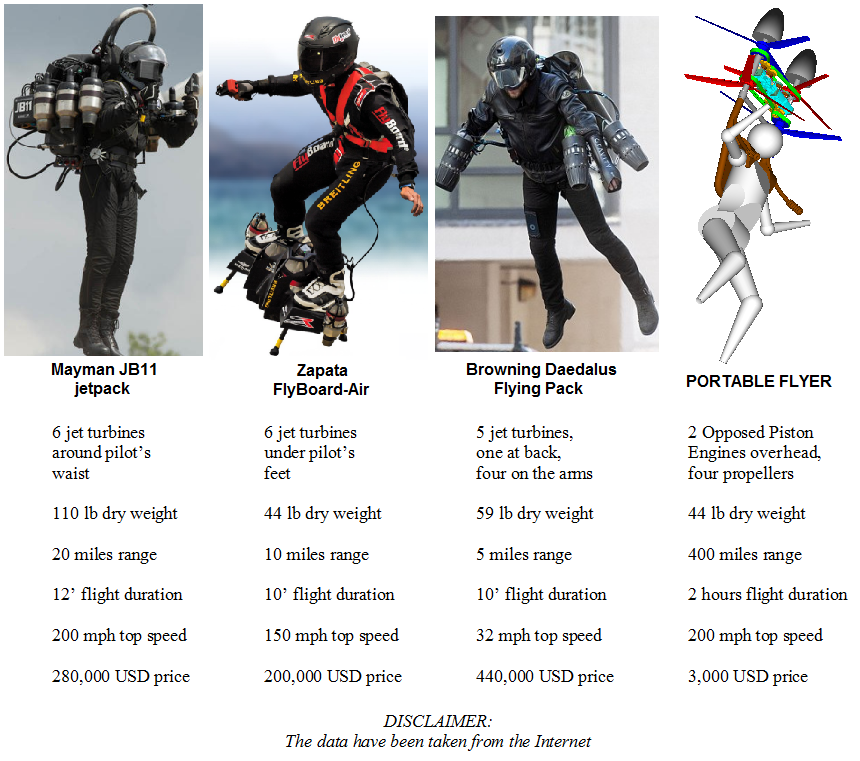Weight and Flying Devices
The JB11 JetPack of Mayman weighs, dry, 50Kg (110lb) :

i.e. 2.5 times more than the Portable Flyer.
For the average person, lifting 20Kg from the ground above their head is not difficult.
For the average person, lifting 50Kg from the ground to their torso height is impossible.
Worse even, for a "decent" range (say 20 miles) Mayman has to carry (to bear on his back) another 70Kg (150lb) of fuel.
For the same range the Portable Flyer needs less than 5Kg of fuel.
I.e. the overall weight of the propulsion unit (including the fuel for 20 miles) of the Portable Flyer is five times lower than that of Mayman's JB11 (20+5=25Kg versus 50+70=120Kg).
Including a 75Kg pilot, the overall take-off weight of the Portable Flyer is half than Mayman's JB11 JetPack.
Where the abovementioned 70Kg of fuel for 20 miles comes from?
According the Internet,
in order to cross the English Channel (~ 22 miles) with his FlyBoard_Air JetPack,
Zapata not only consumed 70 Kg of fuel,
but he had to land on a refueling platform, at the middle of the channel, to refuel.
And why the JetPacks have such low mileage?
The mileage has to do with the BTE (Brake Thermal Efficiency) of the engines used and with the way the thrust is generated.
The low BTE of the turbines of the JetPacks combines with a highly inefficient "propulsion method" wherein the supersonic exhaust gas takes most of the energy provided by the engine, leaving only a small percentage to the flying device.
The 1,000hp (or so) of power from their turbines, for which the JetPack makers are proud of, is indicative.
In simple words: they consume 1,000hp for something that can be done with 50hp.
To the rest requirements of a personal Flying Device (my last post) they have to be added the high BTE of the engines used and the high efficiency of the propulsion system.
For a given range, with half BTE you need to carry two times more fuel.
And with x times less efficient propulsion system (say, jets vs propellers) you have to carry x times more fuel.
While the weight of the fuel in the case of cars and motorcycles is not significant, for Flying Devices it is a crucial factor.
See the body posture of Yves Rossy and his partners:

They barely carry their Flying Devices having fuel for ten minutes of flight.
Quote from https://www.pattakon.com/GoFly/index.html (Abstract) :
- A personal flying device must be lightweight.
The more lightweight (including the fuel or the energy source) the better.
Every oz of additional (beyond pilot's) weight requires additional power and additional fuel; the added weight makes the control of the flight more difficult, the landing more risky and dangerous, the noise louder, the range shorter, the mileage smaller, the emissions worse.
A personal flying device must be as lightweight as possible; and because weight cannot be removed from pilot's body, weight can only be removed from the power unit and from the energy source (fuel or batteries).
Thanks
Manolis Pattakos
